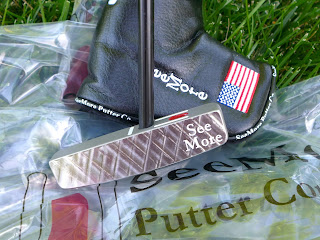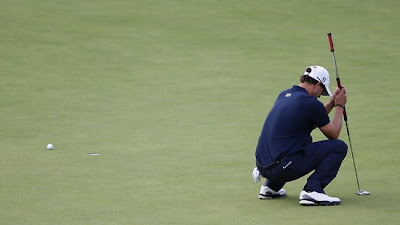Few who play
golf know the difference, but it's a key question.
Sometimes you practice on the golf course and sometimes you play.
You will be
wise to declare the difference before you tee off.
When you play,
golf is game of fewest strokes. It doesn't matter how you get the ball into the
hole, just do it. Don't take mulligans or re-hit shots or putts that may not
have been hit the way you intended. Focus on numbers, focus on shots; get the
ball into the hole and let nothing stand in your way.
Practice
rounds are usually played when the course is uncrowded and you're playing
alone. You can also have a practice round with your instructor called a
teaching lesson. The circumstances of a practice round don't matter. What does matter
is that you have something in mind when you practice. If a certain shot has
been troublesome, a practice round is a good chance to work on it.
If there has
been a problem shot, take some time to look around and try to see what it is
about the shot that makes it hard.
Is the
challenge visual? In other words, does it really just look hard and cause you
to lose confidence or become uncertain?
Is there a
tricky angle that makes it appear that a tree or other hazard will be in your
way?
Look and think.
Ask yourself
what your common miss looks like on that particular shot. Does is usually go
left or right? Too low? Too long?
Be a detective
& be creative in finding a solution.
Please,
don’t groove a miss!
Even though a
practice round is a good chance to practice tough shots, it's important to
remember not to groove a miss.
Grooving a miss is the foolish practice of hitting a tough shot over and over,
without success. How can you tell if you're really practicing or whether you're
grooving a miss? It's pretty easy: First, make sure the shot is doable. A
doable shot is a shot you can get right over 70% of the time. If the shot has
more of 50% likelihood of success (or less) feel free to try the shot you hit
poorly a second time, but no more.
If you hit the
same shot poorly twice in row move on and forget it for now!
The same is
true for putts. I like to hit lots of extra putts when I play a practice round.
But, I only practice hitting putts that can teach me something about the
green's slope, speed or grain. I won't stand there and hit (and miss) the same
tricky downhill / sidehill left to righter. My confidence is shaky enough. I
want to walk off the green during a practice round knowing more about the way
the green plays than I did when I walked onto it.
After your
practice round sit down and enjoy a Diet Coke. Think about your round. Mentally
break your round up into three parts; your full shots, your short game and your
putts. Ask yourself which of the three were the best and ask which of the three
was not what you'd like it to be.
One of the
best ways to get help from an instructor is to be specific when you ask for
their help. You'll be helping your teacher to help you by asking something
like, "Hey pro, I'm having a lot of trouble making solid contact on my
pitches."
Identifying
issues is a positive way of analyzing your game. Analyzing your game should not be about the minute examination of
every movement and swing element. Analysis your game should focus on specifics
that relate to actual shots. The game is golf, not golf swing.
Improve
your masterpiece.
A practice
round can be some of the most fun and enjoyable golf you'll ever play. A
practice round is like a canvas waiting to be painted. Your job is to imagine
the finished painting, as you'd like it to be to be and then judge your
completed effort when you're done with your round. You will never create the
perfect painting; no one ever has. But, golf will give you an infinite number
of chances to improve on your masterpiece.
Enjoy each
one!











